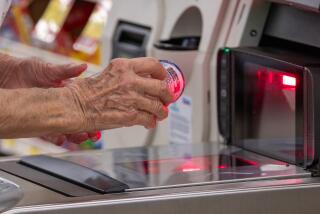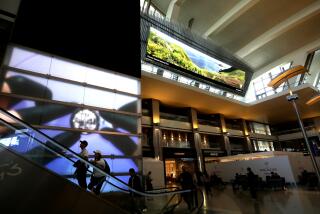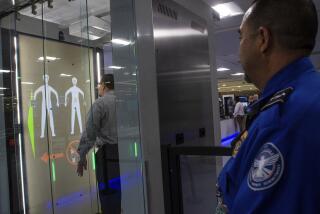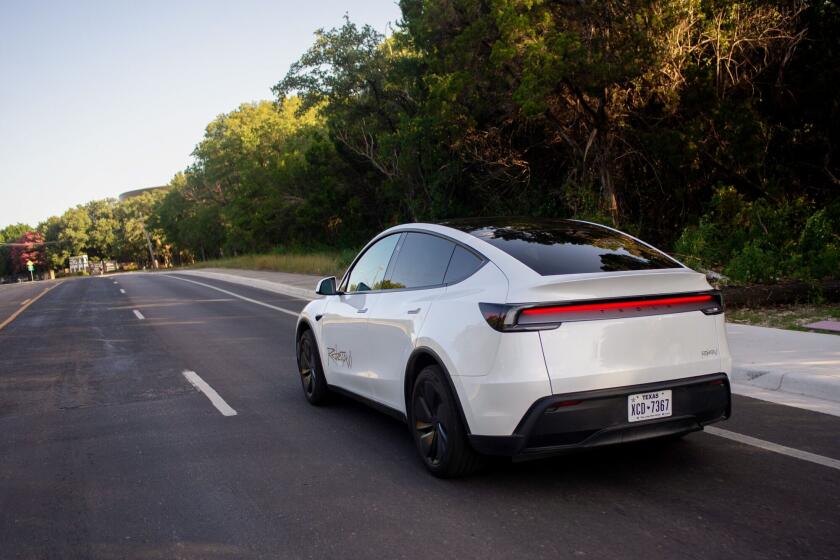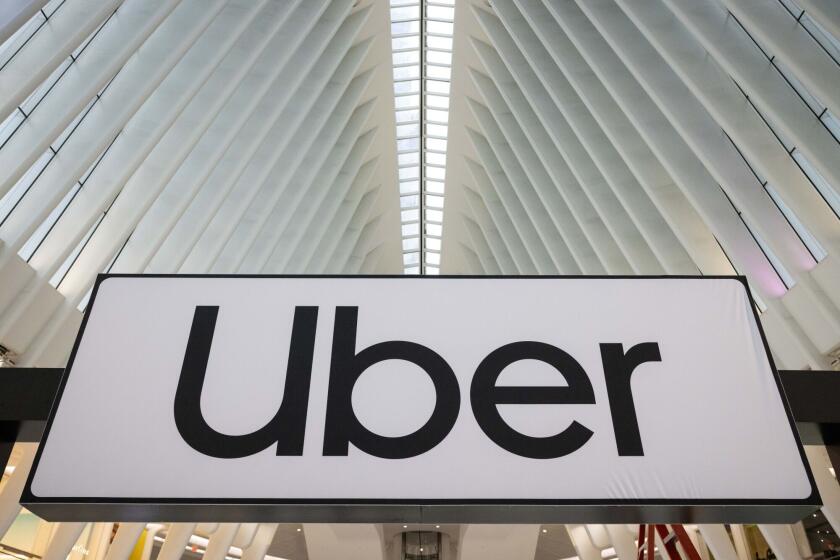Self-serve airport idea could take off in future
- Share via
LAS VEGAS — In this most miserable year ever for airline passengers -- a year of record flight delays and baggage mishandling -- hope is on the horizon.
One solution: an airport where the only people are the passengers. That possibility and technology designed to speed voyagers to their destinations were aired at a conference of airport and airline officials here, providing tantalizing glimpses of a traveling future with fast-moving check-in lines and luggage tracked using radio signals.
Amsterdam’s Schiphol Airport is floating a vision of travelers lined up at self-service kiosks -- similar to ones at grocery stores -- where they would check in, tag their bags, drop them into luggage chutes, select their seats and print out boarding passes.
In about five years, there will be hardly any counters with humans behind them as the new machines will help keep lines shorter and process passengers faster, Schiphol officials predict.
“It’ll be highly efficient,” Marcel van Beek, the airport’s program manager for passenger process, said shortly after unveiling the plan, which drew applause from a packed room at the Mandalay Bay Events Center.
The self-service plan was the big buzz among 300 airline and airport officials who gathered for a two-day conference, which ended Friday, to explore ways to get passengers through airports faster and easier.
Titled Check-in 2007, the conference is noteworthy because it comes at a time when flight delays and mishandled baggage are at their worst since the federal government began tracking the issues in 1995, and some aviation analysts don’t see much relief ahead as more planes and passengers take to the sky. A record 209 million U.S. passengers were expected to have flown this summer, according to the Air Transport Assn.
“People don’t think flying is a whole lot of fun anymore,” said Charles “Duffy” Mees, chief information officer for JetBlue Airways Corp.
Airport officials acknowledge that they can’t prevent flight delays, but they can do something about alleviating travelers’ frustrations with congested airports, lost luggage and long check-in lines.
“We can at least try to make the airport experience a positive one,” said Randall W. Walker, head of Las Vegas’ McCarran International Airport, which hosted the conference.
In an exhibit hall, about 20 companies showcased new machines and devices that airport officials hope can help keep the check-in lines moving.
One European-based company, SITA , was hawking a kiosk that could be installed off-site and enable passengers to check in and print boarding passes for all the major airlines. Currently, self-service kiosks usually serve only one or two airlines.
Edinburgh, Scotland-based Mobiqa Ltd. developed computer software that would enable cellphone users to receive e-mail that contained an image of a bar code, similar to ones found on boarding passes. The passenger would then simply pass the cellphone under an image-reading device to check in or board a plane.
The technology is being tested in Canada but can’t be used in the U.S., at least for now. The Transportation Security Administration still requires a paper boarding pass for passengers flying through U.S. airports.
Airport and airline officials acknowledge that no matter what they do to smooth the check-in process, passengers still face long lines waiting to pass through TSA’s system.
“We have to somehow compensate for their inefficiencies,” JetBlue’s Mees said.
TSA has begun to collaborate more closely with airport officials. Last year it allowed domestic passengers to check their bags off-site after banning the practice after the Sept. 11, 2001, terrorist attacks.
In Los Angeles, passengers using the FlyAway bus shuttles to Los Angeles International Airport can now check in as many as two bags for $5 at the pickup facilities in Van Nuys, Westwood and downtown’s Union Station. They can also get their airline boarding passes.
Passengers can then go directly to security screening and to the boarding gates as the bags are separately transported to an LAX handling facility. There the luggage is inspected by TSA security screeners and then placed on board the passengers’ flights.
The service also is available at the Los Angeles Convention Center for convention visitors and at the Port of Los Angeles for cruise ship passengers. There’s one catch: Passengers must be flying within the United States.
Many of the ideas discussed at the conference, such as a common check-in area for all airlines, seemed remote. But the Schiphol plan appears close to liftoff, airport officials said.
At the Amsterdam airport, a machine would scan a passenger’s passport and then show the flight information on a display screen. The traveler would be able to select a seat and print out a luggage tag, which the passenger would attach before placing it in a chute next to the self-service kiosk.
The bag tag is likely to contain a tiny radio transponder resembling a postage stamp that could be read several feet away, enabling the luggage to be tracked more accurately. The airline would immediately know, for instance, whether a bag made it on a particular flight.
Schiphol officials expect that by 2015, about 90% of its passengers would use the self-service machines, which would enable the airport to handle a projected 50% increase in travelers while reducing the typical time in line by 10%.
It would also alleviate concerns about a workforce shortage; Schiphol officials expect many airport workers to retire over the next five years.
Self-service also makes sense for passengers, who are becoming less dependent on humans for common transactions such as buying groceries or checking out books at the library, said Paul Fijen, manager of passenger service for Dutch carrier KLM, which is working closely with Schiphol on the new check-in process.
“I strongly believe it is more of a value for a customer to be in control from purchasing the ticket to arriving at the destination than to see 10 [ticket] agents who are tired and stressed,” Fijen said.
--
Begin test of infobox
Checking into the future
As air travel misery increases, airport and airline officials grapple with ways to speed passengers to their planes and avoid losing their luggage, including:
* Self-service kiosks that allow passengers to print boarding passes and check in baggage.
* Paper-thin radio-frequency identification tags, similar to transponders used by drivers on toll roads, to be placed on baggage for more accurate tracking.
* Off-site check-in and baggage service so passengers need only to wait in line for the security screening at the airport.
* Use of cellphones as a boarding pass.
--
Source: Times reporting
More to Read
Sign up for The Wild
We’ll help you find the best places to hike, bike and run, as well as the perfect silent spots for meditation and yoga.
You may occasionally receive promotional content from the Los Angeles Times.
